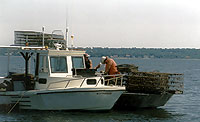|
|
Journals 2003/2004
Steven Krous
Cranston High School West, Cranston, Rhode Island
"Habitat Value of Aquaculture Shellfish Gear"
Narragansett Bay, Rhode Island
Various dates in July and August 2003
|
DAY 2: Wednesday August 13, 2003
 We departed by boat at 9:00 AM today, into fog and calm water. Our boat was a Romarine with a cabin and abundant deck space, around 23 feet in length. We were departing from Wickford Harbor with three scup traps that we were testing for their effectiveness as capture devices for cunner, tautog and sea bass. We set the three traps baited with chopped surf clams in the channel between Fox Island and Rome Point. There is an oyster culture facility to the south at Rome Point but we didn't set traps there today. Maybe next week. Traps went in the water at about 10:15 with a planned set time of two hours. Stephanie says this is plenty of time to allow fish to scent the bait and enter the traps. We returned to the area at 12:30 and pulled the traps, which contained a total of about 50 adult scup, but none of our three target species. We recorded lengths of all scup captured, then returned them to the water. Never miss an opportunity to collect data, right? No telling who might be able to put it to use somewhere down the line.
During the two-hour interim between setting and pulling the traps I got to know Stephanie's two co-workers on sampling days, Chris and Ed. Chris is an undergrad intern like Devin, who is considering switching majors from marine affairs to fisheries. This boat experience should help him make his decision (I think these undergrad internships are a great idea by the way. Don't think they existed when I was an undergrad). Ed has his Masters in Oceanography, but is considering returning to school for his teacher certification. He had many questions for me after I told him how I ended up teaching high school.
We helped Chris to check lobster pots for his project. He is assisting on a study of shell disease impacts to the lobster fishery. Specifically, he is trying to determine if the presence of shell disease alters lobster behavior, perhaps increasing vulnerability to predators or making them less efficient at finding food. He has observed them to be more sluggish in the lab than lobsters showing no evidence of shell disease.
 During this time Stephanie also told me about the elastomer tagging that she and Devin did yesterday on the black sea bass in the tank systems. When we returned to the dock I went to GSO to help Devin check the fish for mortalities or lost tags. It turns out that black sea bass pose a particular challenge with the elastomer tagging method. Their dark pigmentation makes it difficult to see the tag after it has been injected. This problem has forced Graham, Stephanie and Devin to re-think the positioning of the tags. The body locations initially selected will not work so it's back to the drawing board. Devin also told me about another problem that complicated yesterday's tagging effort- the dose of MS 222 anesthetic that they used was not enough, so they were trying to inject very lively sea bass!! Next time they're going to increase the dose significantly, another area of the research that needs a little fine tuning.
All this seems very familiar to me and points out something that I've experienced in my own grant writing and management. Writing successful proposals is generally much easier than converting those proposals into a successful research effort or project. Something to stress to students and mentee- Ideas are great but you must also be willing to follow these up with HARD WORK.
|
|